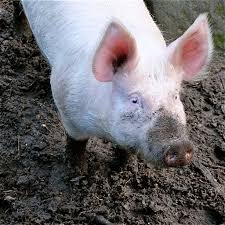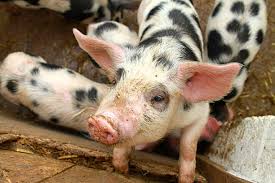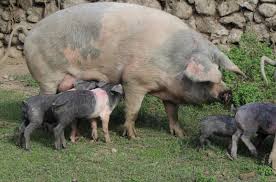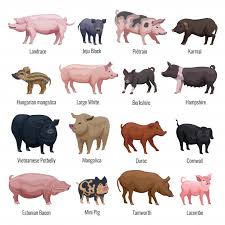Pigs are one of the most widely raised livestock animals globally, valued for their meat, adaptability, and efficient feed conversion. Different breeds have been developed over time to suit various climates, production needs, and environmental conditions.
This article explores some of the common pig breeds found in tropical regions, highlighting their characteristics, advantages, and limitations. The breeds discussed below are merely those found frequently within the tropics.
Black-skinned Breeds
These breeds are popular for their high resistance to sunstroke.
1. Berkshire: This breed is British in origin. It has six white tips. Each end of the legs has one, as well as the snout and tail. The snout is short with prick ears spread apart. The body is quite stocky and low on the ground. The breed has poor prolificacy. Litter size has been reported to be less than seven piglets, with an average of 5.73.
2. Hampshire: This breed is colored black with a white belt around the forequarter of the body. It is medium in size with high prolificacy, good nursing mothers, and efficient feed conversion. It has lop ears and good ham, hence it has a high reputation for ham and bacon production, as well as being a good grazer.
Read Also: Importance of a Fish Net on a Concrete Pond
White Breeds

1. Large White or Yorkshire: This breed has become one of the most widespread in the tropics, including Nigeria, even though it is British in origin. It is a large breed characterized by a long and heavy body carried on strong legs.
The ears are erect, big, triangular, and pricked. The Large White is a highly adaptable breed. The sows are good mothers with high milking ability and prolificacy. They are good feed converters and are used for bacon and pork production. Its limitation is its susceptibility to sunburn.
2. Landrace: It is a Danish breed, although several types are now available, such as Swedish, American, etc. The breed has been popularly used for crossbreeding purposes in many parts of the tropics. Selection objectives have centered on reducing the content of low-priced carcass fat while at the same time increasing the muscle content of the back and hindquarters.
The breed is very prolific with large litter size. The carcasses are also excellent and lean. The problem with this breed is that it is not always quite adaptable in the tropics, and as such, performance characteristics could be low when compared to other breeds such as the Large White.
3. Tamworth: This is also a British breed characterized by a brown coat on white skin. It is long and narrow, while the hair is coarse. The growth rate is considered slow when compared with some other British breeds. It is, however, less susceptible to sunburn and tolerant to changes in diets.
4. Duroc-Jersey: The breed is American in origin. The pigs have high fecundity and are pigs of the land type. The head is slightly concave with the ears carried horizontally. The skin color is red. The body is not as well developed as the Large White breed, but growth performance is considered good.
5. Poland China: An old breed of pig, the Poland China was known earlier as “Hot Type”. The Poland China is believed to be a crossbred developed in the USA from Russian and Big China pigs. The Poland China breed has a color pattern that is similar to that of the Berkshire. This is because the Big China or the Warren hogs had been improved by previously crossing them with the Berkshire.
Like the Berkshire, it has six white points, one on each of the feet, one on the tip of the tail, and one on the tip of the nose. Poland China pigs are generally larger than other modern breeds.
The Poland China’s growth performance has been fairly good in the tropics, although it is susceptible to kidney worms and other parasites. Poland China is an efficient feed converter. With good feeding and management, they grow rapidly. Among the different breeds, they are considered the heaviest at any given age.
6. Spotted Poland China: The present breed of Spotted Poland China can be traced back to the spotted pigs whose ancestors were the original Poland China. The spotted Poland China is of more recent origin than most of the other established American breeds of pig.

The standard color of the Spotted Poland China is 50 percent white and 50 percent black with large, even spots. The Breed Association of the Spotted Poland China requires that the body must be at least 20 percent but not more than 80 percent white. Spotted Poland China pigs sometimes tend to become chubby, with too much fat laid down on the body and neck.
For breeding purposes, strict selection should be conducted to produce meat-type pigs, especially when the Poland China is crossed with indigenous pigs in the tropics. A large number of farmers in the tropics do not quite accept a spotted breed of pig, and for breeding purposes, they prefer a breed with a solid color.
Read Also: Environmental Factors Affecting Feed Consumption in Fishes
Local Breeds

These breeds are, in most cases, black or brown. They are generally small in size when compared with the exotic breeds and are mostly found in the southern part of Nigeria. These pigs are scavengers and could be very destructive to crops. They eat up human and domestic feces and offal when found.
They are usually dirty, sleeping and wallowing in muddy water during the day. These are usually secondary hosts for endo-parasites (e.g., tapeworm) transfer to humans. The cost of production is cheap since the owners do not spend money to purchase drugs and feeds.
The animals are sometimes given kitchen waste in their sleeping places. It is only in a few cases that shelter is provided, and even then, it is usually substandard. The end result, therefore, is that productivity is very low.
The use of exotic breeds for upgrading purposes, provision of adequate shelter, and the feeding of protein and energy supplements are some of the measures that can improve the productivity of these breeds.
Do you have any questions, suggestions, or contributions? If so, please feel free to use the comment box below to share your thoughts. We also encourage you to kindly share this information with others who might benefit from it. Since we can’t reach everyone at once, we truly appreciate your help in spreading the word. Thank you so much for your support and for sharing!
Read Also: Treatment/Transformation of Municipal Solid Waste (MSW)

